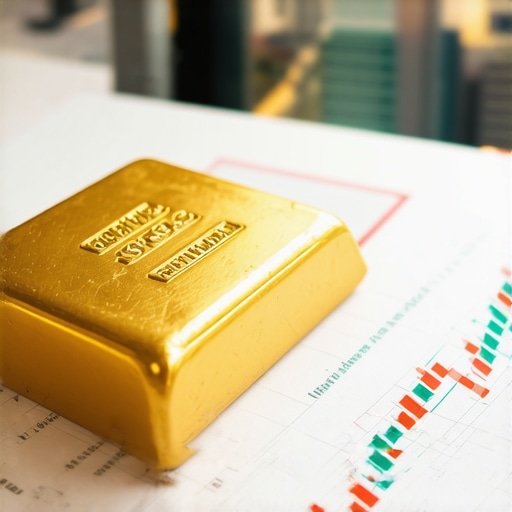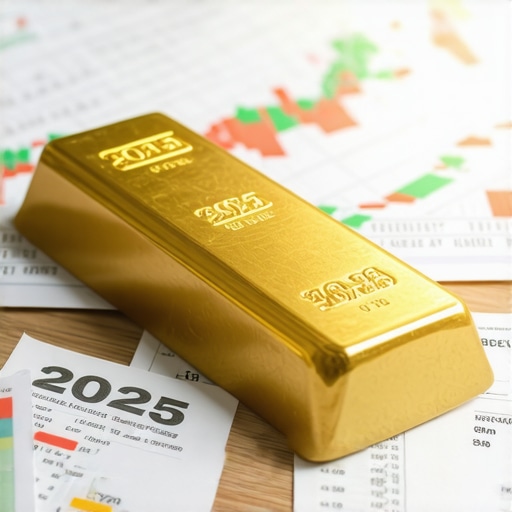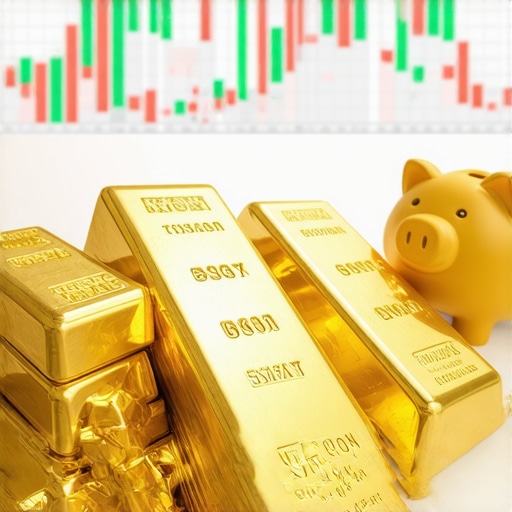Understanding Gold ETFs: A Modern Investment Tool
In the ever-evolving financial landscape, Gold ETFs (Exchange-Traded Funds) have emerged as a popular investment choice for both novice and seasoned investors alike. These funds provide a unique opportunity to invest in gold without the complexities of physical ownership. But what exactly are Gold ETFs, and how can you effectively leverage them in your investment portfolio?
What Are Gold ETFs?
Gold ETFs are financial instruments that track the price of gold and trade on stock exchanges like regular stocks. Each share of a Gold ETF represents a specific amount of gold, allowing investors to gain exposure to gold prices without having to physically buy and store the metal. This can be particularly advantageous for those looking to invest in gold as a hedge against inflation or economic uncertainty.
Benefits of Investing in Gold ETFs
Investing in Gold ETFs comes with several benefits:
- Liquidity: Gold ETFs can be bought and sold on stock exchanges throughout the trading day, providing investors with quick access to their funds.
- Cost-Effectiveness: Investing in Gold ETFs is often more cost-effective than buying physical gold. You avoid costs related to storage and insurance, which can add up over time.
- Diversification: Gold ETFs can enhance your investment portfolio by diversifying your assets, especially in times of market volatility.
How to Choose the Right Gold ETF
When selecting a Gold ETF, consider the following factors:
- Expense Ratio: This is the annual fee that all funds or ETFs charge their shareholders. Look for ETFs with lower expense ratios to maximize your returns.
- Liquidity: Check the trading volume of the ETF. Higher liquidity means you can easily buy and sell shares without significantly affecting the price.
- Fund Size: Larger funds tend to be more stable and less likely to be closed, which can be a risk with smaller funds.
For those who want to dive deeper into the world of gold investments, understanding the advantages of physical gold investments can also provide valuable insights. While Gold ETFs offer convenience, physical gold has its own set of benefits that can complement your overall investment strategy.
Market Trends Influencing Gold ETFs
The performance of Gold ETFs is closely tied to various market dynamics. Factors such as global economic conditions, inflation rates, and central bank policies can all influence gold prices. For instance, when economic uncertainty rises, demand for gold typically increases, driving up prices. This trend often results in a corresponding rise in Gold ETF values, making them a strategic choice during turbulent times.
Moreover, the actions of central banks can significantly impact the gold market. As these institutions adjust their reserves, the demand for gold can shift, subsequently affecting Gold ETFs. Understanding these trends is crucial for making informed investment decisions.
As you explore the world of Gold ETFs, keep in mind that each investor’s needs and goals are unique. Tailoring your investment strategy to align with your financial objectives is essential for achieving success in the gold market.
Understanding the Risks of Gold ETFs
While Gold ETFs present a convenient way to invest in gold, it’s essential to recognize the associated risks. Investors should be aware that Gold ETFs, like all investments, are subject to market fluctuations. The price of gold can be volatile, influenced by various factors such as geopolitical tensions, currency strength, and changes in interest rates. These variables can lead to potential losses if the market moves against your investment.
Market Volatility and Gold ETFs
Market volatility can have a significant impact on the performance of Gold ETFs. For instance, during times of economic stability, investors may prefer riskier assets, causing gold prices to fall. Conversely, in times of crisis, gold often sees increased demand as a safe-haven asset. This duality means that understanding the broader market context is vital for investors. For deeper insights into how global events influence gold prices, consider reading this analysis on global events and gold demand trends.
Comparing Gold ETFs to Other Investment Options
When considering Gold ETFs, it’s crucial to compare them with other investment options, such as physical gold, gold mining stocks, and mutual funds. Each has its own advantages and disadvantages. For instance, while Gold ETFs provide liquidity and ease of trading, physical gold can serve as a tangible asset that may retain value during economic downturns.
Gold Mining Stocks vs. Gold ETFs
Investing in gold mining stocks can be another way to gain exposure to gold. However, this approach carries additional risks tied to the operational performance of the mining companies. Factors such as management decisions, operational costs, and geopolitical issues in mining regions can influence stock prices. In contrast, Gold ETFs reflect the gold market’s performance without the complexities of individual stock investments. To understand better the nuances of investing in gold mining stocks, check out this guide on gold mining stocks.
Tax Considerations for Gold ETFs
Tax implications are an essential factor for investors to consider when investing in Gold ETFs. In many jurisdictions, Gold ETFs are classified similarly to collectibles, leading to higher capital gains tax rates compared to stocks or bonds. It’s advisable to consult with a tax professional to understand how your investments will be taxed and to explore possible strategies for tax efficiency.
Staying Informed with Gold Market Analysis
Staying updated on gold market trends and analysis is vital for making informed decisions regarding Gold ETFs. Investors can benefit from resources that provide insights into price forecasts, demand trends, and economic factors influencing gold prices. For a comprehensive overview of current market dynamics, refer to this detailed analysis on current gold demand trends.
As you navigate the world of Gold ETFs, remember that a well-rounded approach to investing encompasses not just the choice of financial instruments but also a thorough understanding of market conditions, risks, and tax implications. This knowledge will empower you to make strategic decisions that align with your investment goals.
Understanding the Role of Gold ETFs in Investment Portfolios
Gold ETFs not only provide a practical way to invest in gold but also play a significant role in diversifying an investment portfolio. By incorporating Gold ETFs, investors can balance their risk exposure, especially during periods of market fluctuation.
How Gold ETFs Enhance Portfolio Diversification
Including Gold ETFs in your investment strategy can lead to a more resilient portfolio. Gold has historically maintained its value, making it an excellent counterbalance to equities and other volatile assets. As economic conditions shift, the demand for gold often rises, which can help stabilize your overall portfolio performance.
To further explore the advantages of diversifying with gold, consider reviewing the benefits of physical gold investments. This resource elaborates on how tangible gold can complement your ETF holdings.
Timing Your Investment in Gold ETFs
Timing can be crucial when investing in Gold ETFs. Market conditions can fluctuate rapidly, influenced by global events, economic indicators, and investor sentiment. Monitoring these factors can help you make informed decisions about when to buy or sell your Gold ETF shares.
Indicators of Optimal Investment Timing
Key indicators to consider include:
- Economic Reports: Pay attention to reports on inflation, unemployment, and GDP growth, as these can impact gold prices.
- Central Bank Policies: Interest rate changes and central bank gold purchases can significantly affect market dynamics. For instance, when central banks increase their gold reserves, it often signals a bullish trend for gold prices.
- Market Sentiment: Keeping an eye on investor sentiment and market trends can provide insights into potential price movements.
For a deeper look into how central bank actions influence gold demand, check out this article on central banks and gold demand.
Strategies for Investing in Gold ETFs
Implementing effective strategies can enhance your success with Gold ETFs. Consider dollar-cost averaging, which involves consistently investing a fixed amount over time, regardless of price fluctuations. This approach can mitigate the impact of volatility and reduce the risk of making poor investment decisions based on short-term market movements.
Research and Stay Informed
Staying informed about market trends and economic factors is essential for making sound investment decisions. Utilize resources that provide regular updates on gold prices, market analysis, and demand trends. For comprehensive insights into current gold demand trends, refer to this analysis on current gold demand trends.
Evaluating the Performance of Gold ETFs
Continuous evaluation of your Gold ETF investments is vital. Tracking key performance metrics, such as the fund’s expense ratio, historical returns, and market volatility, can help you gauge whether your investment aligns with your financial goals.
Additionally, consider how well the ETF tracks gold prices compared to its benchmarks. Understanding these dynamics allows you to make informed decisions about holding or adjusting your investments.
As you delve deeper into the intricacies of Gold ETFs, remember that the world of gold investment is multifaceted. Whether you’re examining market trends, evaluating risks, or formulating strategies, each aspect plays a crucial role in refining your investment approach. For those eager to further explore how gold prices are impacted by various factors, the next section will uncover essential elements of gold market analysis.
Strategies for Maximizing Returns with Gold ETFs
To optimize your investment in Gold ETFs, implementing effective strategies is key. One popular method is dollar-cost averaging, which involves consistently investing a fixed amount over time regardless of the price fluctuations. This approach helps mitigate the impact of market volatility and reduces the risk of making poor decisions based on short-term market movements.
Researching Market Conditions
Staying informed about market trends and economic indicators is essential for making informed investment decisions. Investors should utilize a variety of resources that provide regular updates on gold prices, market analysis, and demand trends. For comprehensive insights, consider reading this analysis on current gold demand trends. Understanding the dynamics of supply and demand can give you a competitive edge in timing your investments.
Evaluating Gold ETF Performance Metrics
Continuous evaluation of your Gold ETF investments is crucial for ensuring they align with your financial goals. Key performance metrics to track include the fund’s expense ratio, historical returns, and overall market volatility. These metrics can provide insights into how well the ETF tracks gold prices compared to its benchmarks.
Understanding Tracking Error
Another important aspect of evaluating Gold ETFs is the tracking error, which measures how closely an ETF’s performance corresponds to the performance of the underlying asset, in this case, gold. A lower tracking error indicates that the ETF is effectively mirroring gold’s price movements, making it a more reliable investment choice. Investors should also consider how external factors, such as geopolitical events or economic shifts, could affect tracking error.
Gold ETFs: A Hedge Against Inflation
Gold has long been considered a reliable hedge against inflation. During periods of rising prices, the value of gold typically increases, making Gold ETFs an attractive option for investors looking to protect their purchasing power. As inflation concerns grow, demand for gold often rises, creating a favorable environment for Gold ETF performance.
Monitoring Economic Indicators
Key economic indicators, such as inflation rates, interest rates, and employment data, can significantly influence gold prices. For instance, when inflation rates rise, central banks may respond by increasing interest rates, which can also affect gold demand. Understanding these relationships is crucial for investors aiming to strategically position their portfolios. For a deeper understanding of how central bank actions impact gold demand, explore this article on central banks and gold demand.
Tax Implications of Investing in Gold ETFs
Tax implications are an essential consideration for investors in Gold ETFs. In many jurisdictions, Gold ETFs are treated similarly to collectibles, leading to higher capital gains tax rates compared to traditional stocks or bonds. It’s advisable to consult with a tax professional to understand how your investments will be taxed and to explore strategies for tax efficiency.
Staying Ahead of Tax Changes
Tax laws can change, impacting the overall investment landscape. Staying updated on relevant tax regulations ensures that you can make informed decisions regarding your Gold ETF investments. This proactive approach can help maximize your returns and minimize tax liabilities.
Final Thoughts on Investing in Gold ETFs
As you navigate the world of Gold ETFs, it’s essential to adopt a well-rounded approach that encompasses not only the selection of the right ETFs but also an understanding of market conditions, performance evaluation, and tax implications. By doing so, you empower yourself to make strategic decisions that align with your investment objectives and financial goals. For those looking to deepen their understanding of gold investments, consider reviewing this essential guide for beginners, which offers valuable insights into the broader world of gold investment strategies.
Frequently Asked Questions about Gold ETFs
What is a Gold ETF?
A Gold ETF (Exchange-Traded Fund) is a type of fund that tracks the price of gold and is traded on stock exchanges. Each share of a Gold ETF represents a specific quantity of gold, allowing investors to gain exposure to gold prices without the need for physical ownership.
How do Gold ETFs work?
Gold ETFs work by pooling investors’ money to purchase physical gold or gold-related securities. The fund’s performance mirrors the price of gold, providing an easy way for investors to gain exposure to the gold market through stock exchanges.
Are Gold ETFs a safe investment?
While Gold ETFs can provide a hedge against inflation and economic uncertainty, they are not without risk. Gold prices can be volatile and are influenced by various factors such as geopolitical events, currency fluctuations, and market sentiment. Thorough research and understanding of market trends are essential for managing these risks.
What are the tax implications of investing in Gold ETFs?
Gold ETFs are often treated as collectibles for tax purposes, which can lead to higher capital gains tax rates compared to other investment types like stocks and bonds. It’s advisable to consult with a tax professional to understand the tax implications specific to your situation and to explore strategies for minimizing tax liabilities.
How do I choose the right Gold ETF?
When choosing a Gold ETF, consider factors such as the expense ratio, liquidity, fund size, and how well the ETF tracks gold prices. Researching these aspects will help you find a Gold ETF that aligns with your investment goals.
Can I invest in Gold ETFs through a retirement account?
Yes, many retirement accounts, such as IRAs, allow for investments in Gold ETFs. This can be a strategic way to include gold in your retirement portfolio while taking advantage of tax benefits.
What is the difference between Gold ETFs and physical gold?
Gold ETFs provide liquidity and ease of trading compared to physical gold, which requires handling and storage. However, physical gold can serve as a tangible asset that may retain value during economic downturns, offering potential benefits that Gold ETFs do not provide.
How do Gold ETFs perform during economic downturns?
Gold ETFs often perform well during economic downturns as investors typically turn to gold as a safe-haven asset. Increased demand for gold during times of economic uncertainty can lead to rising ETF values, making them a strategic investment choice.
What are some strategies for maximizing returns with Gold ETFs?
To maximize returns with Gold ETFs, consider strategies like dollar-cost averaging, staying informed about market trends, and continuously evaluating performance metrics such as expense ratios and tracking errors. These methods can help you make informed decisions and optimize your investments.
Authority Resources for Gold ETF Investors
To further enhance your understanding of Gold ETFs and the gold market, consider exploring the following authoritative resources:
- SPDR Gold Shares – One of the largest Gold ETFs, providing insights into market trends and gold investment strategies.
- Vanguard – Offers a wealth of information on various investment options, including Gold ETFs.
- World Gold Council – An essential resource for market research, data, and insights related to gold investments.
- Investopedia – A comprehensive source for financial education, covering everything from basic concepts to advanced investment strategies.
- Forbes – Renowned for providing expert insights and news on financial markets, including gold and precious metals.
Conclusion: The Strategic Importance of Gold ETFs in Your Investment Portfolio
Investing in Gold ETFs can be a strategic move for those looking to diversify their portfolios and hedge against market volatility. Understanding the intricacies of Gold ETFs—including their benefits, risks, and performance metrics—will empower you to make informed investment decisions. As you continue to navigate the gold investment landscape, remember to stay updated on market trends and seek expert advice when necessary. With the right approach, Gold ETFs can play a crucial role in enhancing your investment strategy and achieving your financial goals.










This guide really highlights the practical advantages of Gold ETFs, especially their liquidity and cost-efficiency compared to physical gold. From my experience, investing in Gold ETFs has simplified access to gold exposure without the hassle of storage and security concerns. However, I also appreciate the post’s emphasis on understanding market volatility and tracking error—a factor many investors overlook. I once underestimated how geopolitical events could affect gold prices and, consequently, ETF performance. The section on tax considerations is particularly valuable since higher capital gains tax rates on Gold ETFs compared to stocks can catch investors off guard. What’s key is integrating Gold ETFs into a diversified portfolio to balance out risk, especially with inflation concerns on the rise. The suggested strategy of dollar-cost averaging also resonates with me as it cushions against price swings. Overall, the post offers a comprehensive framework for anyone considering gold investments, blending convenience with critical insights into market trends and risks. It’s a reminder that while Gold ETFs offer accessibility, thorough research and strategic planning are essential for optimizing their benefits.